
Scarlet Street is a 1945 American film noir directed by Fritz Lang. The screenplay concerns two criminals who take advantage of a middle-aged painter in order to steal his artwork. The film is based on the French novel La Chienne by Georges de La Fouchardière, which had been previously dramatized on stage by André Mouëzy-Éon, and cinematically as La Chienne (1931) by director Jean Renoir.

Joan Geraldine Bennett was an American stage, film, and television actress. She was one of three acting sisters from a show-business family. Beginning her career on the stage, Bennett appeared in more than 70 films from the era of silent films, well into the sound era. She is best remembered for her film noir femme fatale roles in director Fritz Lang's films—including Man Hunt (1941), The Woman in the Window (1944), and Scarlet Street (1945)—and for her television role as matriarch Elizabeth Collins Stoddard in the gothic 1960s soap opera Dark Shadows, for which she received an Emmy nomination in 1968.

Robert Bushnell Ryan was an American actor and activist. Known for his portrayals of hardened cops and ruthless villains, Ryan performed for over three decades. He was nominated for the Academy Award for Best Supporting Actor for his role in the film noir drama Crossfire (1947).

Cat People is a 1942 American supernatural horror film directed by Jacques Tourneur and produced for RKO by Val Lewton. The film tells the story of Irena Dubrovna, a newly married Serbian fashion illustrator obsessed with the idea that she is descended from an ancient tribe of Cat People who metamorphose into black panthers when aroused. When her husband begins to show interest in one of his coworkers, Irena begins to stalk her. The film stars Simone Simon as Irena, and features Kent Smith, Tom Conway, and Jane Randolph in supporting roles.
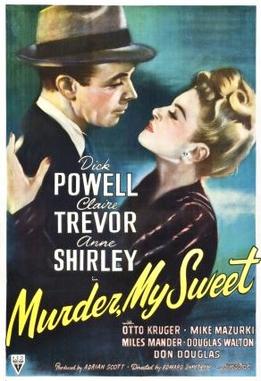
Murder, My Sweet is a 1944 American film noir, directed by Edward Dmytryk and starring Dick Powell, Claire Trevor and Anne Shirley. The film is based on Raymond Chandler's 1940 novel Farewell, My Lovely. It was the first film to feature Chandler's primary character, the hard-boiled private detective Philip Marlowe.

The Curse of the Cat People is a 1944 American psychological supernatural thriller film directed by Gunther von Fritsch and Robert Wise, produced by Val Lewton, and starring Simone Simon, Kent Smith, Jane Randolph, and Ann Carter. Its tells a story about a young girl who befriends the ghost of her father's deceased first wife, a Serbian fashion designer who descended from a race of people who could transform into cats. The film, which marks Wise's first directing credit, is a sequel to Cat People (1942) and has many of the same central characters, but the plot is only tangentially related to its predecessor.

Val Lewton was a Russian-American novelist, film producer and screenwriter best known for a string of low-budget horror films he produced for RKO Pictures in the 1940s. His son, also named Val Lewton, was a painter and exhibition designer.

Born to Kill is a 1947 RKO Pictures American film noir starring Lawrence Tierney, Claire Trevor and Walter Slezak with Esther Howard, Elisha Cook Jr., and Audrey Long in supporting roles. The film was director Robert Wise's first film noir production, preceding his later work on The Set-Up (1949) and The Captive City (1952).
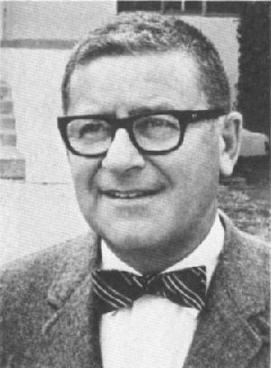
Mark Robson was a Canadian-American film director, producer, and editor. Robson began his 45-year career in Hollywood as a film editor. He later began working as a director and producer. He directed 34 films during his career, including Champion (1949), Bright Victory (1951), The Bridges at Toko-Ri (1954), Peyton Place (1957), The Inn of the Sixth Happiness (1958), Von Ryan's Express (1965), Valley of the Dolls (1967), and Earthquake (1974).
Nicholas Musuraca, A.S.C. was a motion-picture cinematographer best remembered for his work at RKO Pictures in the 1940s, including many of Val Lewton's series of B-picture horror films.
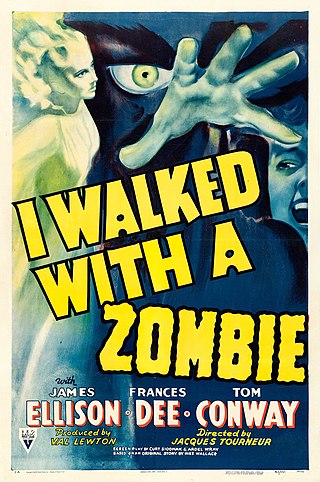
I Walked with a Zombie is a 1943 American horror film directed by Jacques Tourneur and produced by Val Lewton for RKO Pictures. It stars James Ellison, Frances Dee, and Tom Conway, and follows a Canadian nurse who travels to care for the ailing wife of a sugar plantation owner in the Caribbean, where she witnesses Vodou rituals and possibly encounters the walking dead. The screenplay, written by Curt Siodmak and Ardel Wray, is based on an article of the same title by Inez Wallace, and also partly reinterprets the narrative of the 1847 novel Jane Eyre by Charlotte Brontë.
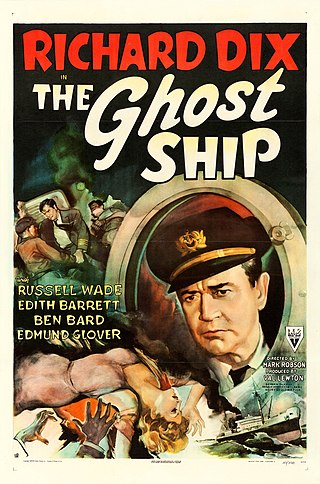
The Ghost Ship is a 1943 American black-and-white psychological thriller film starring Richard Dix and directed by Mark Robson. It was produced by Val Lewton for RKO Radio Pictures as part of a series of low-budget horror films. The film can be seen as a "low-key psychological thriller", a "suspense drama", and a "waterlogged melodrama"., Russell Wade, Edith Barrett, Ben Bard and Edmund Glover in support.
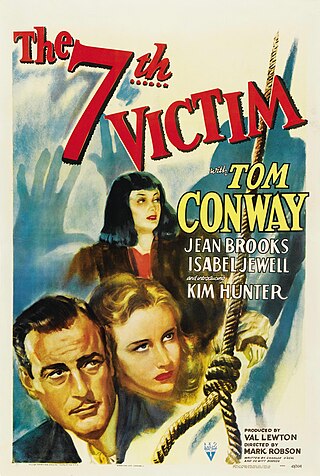
The Seventh Victim is a 1943 American horror film directed by Mark Robson, and starring Tom Conway, Jean Brooks, Isabel Jewell, Kim Hunter, and Hugh Beaumont. Written by DeWitt Bodeen and Charles O'Neal, and produced by Val Lewton for RKO Radio Pictures, the film focuses on a young woman who stumbles on an underground cult of devil worshippers in Greenwich Village, New York City, while searching for her missing sister. It marks Robson's directorial debut, and was Hunter's first onscreen role.

Bedlam is a 1946 American horror film directed by Mark Robson and starring Boris Karloff, Anna Lee and Richard Fraser, and was the last in a series of stylish horror B films produced by Val Lewton for RKO Radio Pictures. The film was inspired by William Hogarth's 1732–1734 painting series A Rake's Progress, and Hogarth was given a writing credit.

Isle of the Dead is a 1945 horror film directed by Mark Robson and made for RKO Radio Pictures by producer Val Lewton. The film's script was inspired by the painting Isle of the Dead by Arnold Böcklin, which appears behind the title credits, though the film was originally titled Camilla during production. It was written by frequent Lewton collaborator Ardel Wray. It starred Boris Karloff. Isle of the Dead was the second of three films Lewton made with Karloff, and the fourth of five pictures Robson directed for Lewton.

The Bigamist is a 1953 American drama film noir directed by Ida Lupino starring Joan Fontaine, Ida Lupino, Edmund Gwenn and Edmond O'Brien. Producer/Screenwriter Collier Young was married to Fontaine at the time and had previously been married to Lupino. The Bigamist has been cited as the first American feature film made in the sound era in which the female star of a film directed herself.

Beauty for the Asking is a 1939 film drama produced by RKO Pictures, and starring Lucille Ball and Patric Knowles.
Charles Koerner was an American film executive, best known for being executive vice president over production at RKO Pictures from 1942 to 1946.

Ardel Wray was an American screenwriter and story editor, best known for her work on Val Lewton's classic horror films in the 1940s. Her screenplay credits from that era include I Walked with a Zombie, The Leopard Man and Isle of the Dead.
Horror noir is a film genre that blends elements of horror and noir genres. It is presented in a dark, brooding tone, style, or mood for the majority of the film while also providing terrifying sequences and prospects. Genres of this kind are primarily intended to play the audience through their darker and more fatalistic elements, to the point where the plotline is effectively turned negative due to its suspenseful and cynical atmosphere. Films with noir aspects are akin to those that are gothic and black-and-white in that their primary purpose is to create a sense of suspense and gloom.

















